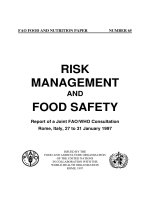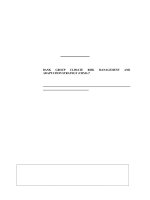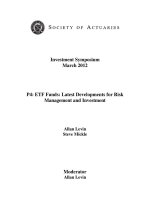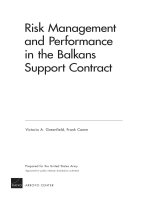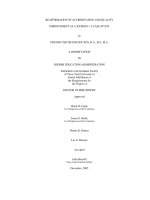risk management and quality improvement handbook
Bạn đang xem bản rút gọn của tài liệu. Xem và tải ngay bản đầy đủ của tài liệu tại đây (1.75 MB, 81 trang )
EQuIPNational Resource
RISK MANAGEMENT & QUALITY IMPROVEMENT
HANDBOOK
Risk Management and Quality Improvement Handbook, July 2013
Produced by the Australian Council on Healthcare Standards (ACHS)
Copies available from the ACHS website: www.achs.org.au/
Copyright © the Australian Council on Healthcare Standards (ACHS)
This work is copyright. Apart from any use as permitted under the Copyright Act 1968, no part may
be reproduced by any process without prior written permission from The Australian Council on
Healthcare Standards. Requests and enquiries concerning reproduction and rights should be
addressed to the Chief Executive, The Australian Council on Healthcare Standards, 5 Macarthur
Street, ULTIMO NSW 2007 Australia.
Telephone: 61 2 9281 9955
Facsimile: 61 2 9211 9633
Recommended citation: The Australian Council on Healthcare Standards (ACHS), Risk
Management and Quality Improvement Handbook. Sydney Australia; ACHS; 2013.
First edition (EQuIP 4):
Second edition (EQuIP5):
Third edition (EQuIPNational):
2007
2011
2013
This Handbook is only available via the ACHS website and may be revised annually. In this case,
the version number and date in the footer will change.
ISBN 13: 978-1-921806-46-9
Developed by Deborah Jones – Manager, Standards and Program Development
The Australian Council on Healthcare Standards.
The ACHS would like to thank the following people for their time and expertise in reviewing the
content of this document:
Cathy Balding,
Director, Qualityworks P/L
Joy Brumby,
ACHS Education Manager
Gillian Clark,
ACHS Education
Consultant
Karen Edwards,
ACHS Surveyor, CEO /
DON Calvary Health Care
Sydney
Vince Gagliotti,
ACHS Surveyor, Quality
Manager, St Vincent’s
Hospital, Melbourne
Elizabeth Kingsley
ACHS Project Officer
Standards and Product
Development
Sue Gilham,
ACHS Survey Coordinator
Kaye Hogan,
ACHS Survey Coordinator
Ros Pearson,
ACHS Contracted Survey
Coordinator
Sandy Thomson,
ACHS Contracted Survey
Coordinator
Page 2 of 81
Copyright © The Australian Council on Healthcare Standards (ACHS)
Risk Management and Quality Improvement Handbook. EQuIPNational. July 2013
Contents
Definitions ................................................................................................. 5
Introduction ............................................................................................... 6
The EQuIPNational Framework ............................................................................................ 6
The EQuIPNational Standards .............................................................................................. 7
Risk Management and Quality Improvement ....................................................................... 8
Developing a Commitment to Risk Management and Quality Improvement using
EQuIPNational. ...................................................................................................................... 9
Incorporating Risk Management and Quality Improvement into Organisational Planning
.............................................................................................................................................. 10
Section 2 .................................................................................................. 12
Creating an Improving Organisation .................................................................................. 12
Organisational Culture and Change Management ............................................................ 12
The change model .............................................................................................................................. 15
Team building ..................................................................................................................................... 18
Summary .............................................................................................................................. 19
Section 3 .................................................................................................. 20
Risk Management Essentials.............................................................................................. 20
Risk Management System Requirements .......................................................................... 20
Responsibilities and Accountabilities ............................................................................... 23
Risk Management Resources ............................................................................................. 24
Risk Management Processes and Strategies .................................................................... 26
The Risk Register ................................................................................................................ 29
Summary .............................................................................................................................. 32
Section 4 .................................................................................................. 33
Quality Improvement .............................................................................. 33
Quality Cycle ........................................................................................................................ 33
Quality Improvement Essentials ........................................................................................ 36
Identifying Areas Requiring Improvement ......................................................................... 41
Sentinel events, adverse events and root cause analysis .................................................................. 41
Incident monitoring ............................................................................................................................. 44
Page 3 of 81
Copyright © The Australian Council on Healthcare Standards (ACHS)
Risk Management and Quality Improvement Handbook. EQuIPNational. July 2013
Gap analysis ....................................................................................................................................... 45
Surveys ............................................................................................................................................... 46
Patient feedback systems ................................................................................................................... 47
Rapid appraisals ................................................................................................................................. 48
Audits .................................................................................................................................................. 49
Accreditation survey results and recommendations ........................................................................... 50
Clinical indicators ................................................................................................................................ 51
Patient journey surveys ...................................................................................................................... 52
Benchmarking ..................................................................................................................................... 53
Summary .............................................................................................................................. 57
Section 5 .................................................................................................. 58
Quality Improvement Tools................................................................................................. 58
Using the Right Tool for the Task....................................................................................... 58
Identifying the current steps in a process ........................................................................................... 59
Analysing the process ......................................................................................................................... 59
Planning solutions to improve the process ......................................................................................... 59
Measuring improvements ................................................................................................................... 60
Affinity diagrams ................................................................................................................................. 61
Bar charts / graphs ............................................................................................................................. 62
Brainstorming ...................................................................................................................................... 63
Cause and Effect (Fishbone) .............................................................................................................. 64
Control charts...................................................................................................................................... 64
Failure Mode Effects Analysis (FMEA) ............................................................................................... 65
Flow charts .......................................................................................................................................... 68
Histograms .......................................................................................................................................... 70
Pareto charts....................................................................................................................................... 70
Run charts / line graphs ...................................................................................................................... 72
Section 6 .................................................................................................. 73
Evaluation ............................................................................................................................ 73
Structure, process and outcome ........................................................................................ 75
Structure ............................................................................................................................................. 76
Process ............................................................................................................................................... 76
Outcome ............................................................................................................................................. 77
Conclusion ........................................................................................................................... 78
Page 4 of 81
Copyright © The Australian Council on Healthcare Standards (ACHS)
Risk Management and Quality Improvement Handbook. EQuIPNational. July 2013
Definitions
1
Quality: the extent to which a health care service or product produces a desired outcome.
Quality improvement: an ongoing response to quality assessment data about a service in ways that
improve the processes by which services are provided to consumers / patients.
2
Quality Improvement Plan: a document that outlines at a minimum what area requires improvement,
how an organisation intends to carry out that improvement, timeframes and responsibilities.
The size, type, complexity and location of the organisation will influence the activities to be undertaken.
The Quality Improvement Plan should be provided to ACHS with the self-assessments in the non-survey
phases of the accreditation cycle. It should also be available for surveyors to review at any onsite surveys.
3
Risk: the effect of uncertainty on objectives. A healthcare organisation’s objectives have different
aspects, such as clinical, financial, health and safety or environmental, and they apply at the strategic,
organisation-wide, unit, project or process levels. In the context of risk, uncertainty is defined as “the state,
even partial, of deficiency of information related to understanding or knowledge of an event, its
consequence, or likelihood”. Any deviation from the expected can result in a positive and/or negative
effect. Therefore, any type of risk, whatever its nature, may have either (or both) positive or negative
consequences.
Risk management: the coordinated activities to direct and control an organisation with regard to risk.
3
Risk management process: the systematic application of management policies, procedures and
practices to the activities of communicating, consulting, establishing the context, and identifying,
analysing, evaluating, treating, monitoring and reviewing risk.
3
Risk Register: a centralised record that identifies for each known risk:
a description of the risk, its causes and its impact
an outline of the existing controls, including the person accountable for managing the risk
an assessment of the consequences of the risk should it occur and the likelihood of the consequence
occurring, given the controls
a risk rating
an overall priority for the risk.
Page 5 of 81
Copyright © The Australian Council on Healthcare Standards (ACHS)
Risk Management and Quality Improvement Handbook. EQuIPNational. July 2013
Introduction
This document is the Risk Management and Quality Improvement Handbook. It is designed to
complement the EQuIPNational programs of The Australian Council on Healthcare Standards
(ACHS) by providing information to assist member organisations with the development of their
Quality Improvement Plan and Risk Register, which are requirements of the EQuIPNational
program, and the National Safety and Quality Health Service (NSQHS) Standards program.
This publication is available from the members’ section of the ACHS website as an eBook.
The EQuIPNational Framework
The key components of EQuIPNational are:
Ten NSQHS Standards that organisations are required to be accredited against
Five ACHS EQuIP-content Standards that build on concepts in the NSQHS Standards and
cover the performance of service delivery, care provision and non-clinical systems
A yearly Self-Assessment to evaluate organisational performance against the Standards
Provision by the member organisation of a Risk Register and a Quality Improvement Plan
ACHS assistance and guidance on the organisation’s Self-Assessment
Biennial onsite surveys by an external, experienced team of ACHS accreditation surveyors,
to provide an independent assessment of the organisation’s performance against the
Standards and recommendations for improvement
The improvement process undertaken by organisations to address the recommendations
from the onsite surveys.
It is envisaged that a planned, systematic approach to implementing the EQuIPNational
Program will support and enable organisations to achieve successfully their mission and goals
and organisational effectiveness.
Page 6 of 81
Copyright © The Australian Council on Healthcare Standards (ACHS)
Risk Management and Quality Improvement Handbook. EQuIPNational. July 2013
The EQuIPNational Standards
The ACHS EQuIPNational program consists of 15 Standards, including the ten NSQHS
Standards:
And the five EQuIP-content standards:
Page 7 of 81
Copyright © The Australian Council on Healthcare Standards (ACHS)
Risk Management and Quality Improvement Handbook. EQuIPNational. July 2013
Section 1
Risk Management and Quality Improvement
Quality improvement has always been an integral part of EQuIP. ACHS provides information on
risk management and quality improvement within this handbook to assist organisations to
manage risks at the organisational, division, department and system levels and to ensure that
quality of care and services are integrated.
The EQuIPNational program provides a framework for organisations to evaluate their
performance in risk management and quality improvement. It is expected that each organisation
will identify and implement effective risk and quality management processes consistently and in
accordance with the organisation’s role. ACHS surveyors will consider risk management
processes, consumer / patient safety and quality of care and services when assessing
organisational performance against each action and when making suggestions and
recommendations on survey results.
Healthcare organisations’ systems for risk management and quality improvement are reviewed
within the National Safety and Quality Health Service (NSQHS) Standards under Standard 1:
Governance for Safety and Quality in Health Service Organisations. In addition, NSQHS
Standards 3-10 require organisations to undertake a risk assessment of their systems. For
example, NSQHS Standard 4 requires a risk assessment of medication management systems.
These risk assessments are managed by the associated governance committees with key risks
also being represented on the organisation-wide Risk Register. The same applies for quality
plans. Organisations are required to submit a Quality Improvement Plan at each phase of their
accreditation cycle and have a register of the organisational risks (Risk Register) available for
ACHS surveyors at each onsite survey. This Risk Management and Quality Improvement
Handbook is provided to assist organisations to develop and monitor both the organisation-wide
Risk Register and the Quality Improvement Plan.
The risk management information in this handbook does not duplicate or replace AS/NZS ISO
31000:2009 Risk Management, but is designed to provide some further healthcare-relevant
information and guidance, and focuses on risk management systems.
Page 8 of 81
Copyright © The Australian Council on Healthcare Standards (ACHS)
Risk Management and Quality Improvement Handbook. EQuIPNational. July 2013
Developing a Commitment to Risk Management and Quality
Improvement using EQuIPNational.
Risk management and quality improvement are not isolated processes. They provide a
framework for considering everything an organisation does, how it is done, and identifying ways
to make it even better – before problems are identified. Many organisations have successfully
implemented effective risk management and quality improvement programs where staff are keen
to participate and share their experiences. Networking and discussion with peers can help to
identify problems and potential solutions to improve outcomes and reduce risk.
For risk management and quality improvement programs to be most effective, the governing
body and leadership team must demonstrate commitment to the processes and define their
expectations for all stakeholders. In addition, the leadership team should ensure that there are
sufficient resources to meet the requirements of the organisation and systems to effectively
mitigate, control and manage all risks, and that attention is focused on the core business of the
organisation – to care for and treat consumers / patients in a safe and high quality clinical
environment
Implementing the systems and processes that assist an organisation to become a safe and
accountable healthcare environment for consumers / patients, staff and healthcare providers
requires ongoing attention. Applying EQuIPNational as an organisation-wide quality program
provides a means to monitor and manage identified risks and continually improve those systems
and processes.
Risk management and quality improvement systems are both directed to providing a structured
framework for identification, analysis, treatment / corrective action, monitoring and review of
risks, problems and/or opportunities. Communication and consultation with stakeholders are
critical for these processes to work effectively.
Continuous improvement and risk management are data driven. They depend on relevant
information being provided to the executive, clinicians, managers and the governing body. The
data and information provided should reflect the issues that are most significant to the
organisation, rather than just for the process of data and information collection itself.
A range of tools that can be used for quality improvement also applies to analysing risk issues.
This handbook provides some examples of these tools to assist organisations to implement risk
Page 9 of 81
Copyright © The Australian Council on Healthcare Standards (ACHS)
Risk Management and Quality Improvement Handbook. EQuIPNational. July 2013
management and quality improvement processes and programs. These are not just sets of
management tools; although there are numerous tools and skills available to develop and utilise,
there are also principles and frameworks for using these tools that are required to ensure
effective systems are implemented.
Incorporating Risk Management and Quality Improvement
into Organisational Planning
Quality improvement and the management of risks in health care should be part of both strategic
and operational planning in every area and service of healthcare delivery, clinical and nonclinical. Risk management and quality improvement should be considered as an integrated
approach when determining clinical practice, equipment design and procurement, capital
development, information technology, contractor management, workplace health and safety,
workforce management, and financial planning, and all other areas of operation.
To determine the priorities of risk management and quality improvement, the approach to
quality, and the structure of an internal improvement and risk management program, the
organisation should identify:
Its stakeholders
What its priorities are:
What activities has the strategic plan highlighted?
How will risk management and improvement activities relate to the strategic goals?
What problems have been identified and/or are reported?
Are there external requirements that must be achieved?
What aspects of care should be targeted?
Are there particular clinical areas that need support?
What resources are available to make improvements and manage risks?
What expertise do staff have in quality improvement and risk management?
What are the greatest risks to the organisation?
What are the greatest opportunities for the organisation?
What are the consequences of those risks or opportunities?
What is the likelihood of those risks or opportunities occurring?
Page 10 of 81
Copyright © The Australian Council on Healthcare Standards (ACHS)
Risk Management and Quality Improvement Handbook. EQuIPNational. July 2013
What approach and structure to take:
How will the governing body be involved?
Who will be responsible for and coordinate the activities and programs?
How will the organisation involve the staff?
How will the organisation communicate its plans for improvement and risk management
to stakeholders?
How will progress be monitored?
How will improvements be monitored?
What body / group / committee will monitor progress and/or improvements?
What tools should be utilised?
Outcomes from the above questions can be incorporated into the organisation’s strategic and
operational plans, which should be linked together. The organisation may choose to develop a
separate plan for risk management and quality improvement, but this should also be reflected in
the operational and strategic plans.
The specific risk management and quality improvement actions in Standard 1 of the NSQHS
Standards focus on the overarching framework that promotes integration of risk management
with quality improvement strategies and informs decision making and planning. The risk
management and quality improvement actions in Standard 1 are core actions and organisations
must obtain a Satisfactorily Met rating in these to gain or maintain accreditation.
The NSQHS Standard 1 risk management item (1.5) and actions (1.5.1 and 1.5.2) require
organisations to establish an organisation-wide “system that incorporates identification,
assessment, rating, controls and monitoring for patient safety and quality”. The quality
improvement item (1.6) and actions (1.6.1 and 1.6.2) require organisations to establish an
organisation-wide system “that monitors and reports on the safety and quality of patient care and
informs changes in practice”.
Both of these items include the requirement for organisations to regularly monitor an
organisation-wide Risk Register and quality management system and to take action to minimise
risks to consumer / patient safety and quality of care.
Systems for risk management and quality improvement apply across all of the 15 EQuIPNational
Standards, and organisations should monitor their ongoing success through its processes of
governance and evaluation.
Page 11 of 81
Copyright © The Australian Council on Healthcare Standards (ACHS)
Risk Management and Quality Improvement Handbook. EQuIPNational. July 2013
Section 2
Creating an Improving Organisation
An essential first step when getting started on process improvement is for the governance or
leadership team to make it a priority. The importance of process improvement must be
communicated from the top. Leaders need to foster an organisational environment in which a
process improvement mentality can thrive and staff are using quality-related tools and
techniques on a regular basis.
Instilling a process improvement mentality in an organisation can be challenging as it sometimes
requires a different way of thinking than staff are usually accustomed to. Process improvement
requires thinking to change from ‘fire fighter’ to ‘fire preventer’. The focus is on improving a
process in the long term, not just patching up procedures and processes as problems occur. To
get started on process improvement, leaders should ensure the culture of the organisation is
one of support and encouragement, which provides the necessary resources of people, time and
training. In some cases, this may require organisations to review their culture and instigate
change management if required.
Organisational Culture and Change Management
The pursuit of managerial excellence has many labels – reform, renewal, modernisation,
transformation, realignment4 – but all are about changing the behaviours that characterise
management culture. Organisational culture is fundamental to the organisation achieving
effective risk management and quality improvement outcomes.
Culture defines:
what the organisation is
what it stands for
what it considers important
the way staff are expected to behave and how they relate to one another
how things are done
...and influences the feelings that people have about the organisation.
Page 12 of 81
Copyright © The Australian Council on Healthcare Standards (ACHS)
Risk Management and Quality Improvement Handbook. EQuIPNational. July 2013
Cultural change can be successful only when an organisation has a good understanding of the
difference between the culture it currently has, and the culture it is trying to build. Clear and
objective measurement is one common feature of successful cultural change.
People within an organisation often do not recognise the culture of that organisation, its values
and behaviours. It often takes an external person or entity to identify the culture and assist an
organisation to change. This external view can be provided during an onsite survey and in the
survey report; ACHS surveyors may assist and support organisational change through feedback.
One view of culture is that it can be likened to an iceberg.5 Above the water can be seen the
behaviours, below the water are the values that support those behaviours. The values are the
larger part of the culture. If the only attempts at change are at the behavioural level, without
attempting to change the values of the lower half of the iceberg, change will not occur.
How can a culture be changed?
In order to bring about change, managers should recognise, as a minimum:
the forces creating or driving the need for change
the right time and environment for change
any resistance to change.
Figure 2.1: The iceberg model of culture
Forces creating the need for change
These forces may be external or internal and may be linked, particularly in relation to values and
attitudes. New personnel bring different values and attitudes as they enter the organisation and
create change from within.
Page 13 of 81
Copyright © The Australian Council on Healthcare Standards (ACHS)
Risk Management and Quality Improvement Handbook. EQuIPNational. July 2013
Internal forces: any factor in the internal environment that influences the way the organisation
conducts its activities, for example:
advances in technology; automated equipment may require a complete change in work
routines and training requirements
employee attitudes and behaviour; patterns of decision making, ability to adapt to changing
circumstances, morale and motivation
costs and resource allocation.
External forces: any factor in the external environment that influences the way the organisation
or service conducts its activities, for example:
relevant Acts, legislation, regulations, Australian Standards, codes of practice and industry
guidelines
population demographics including social and community groups, changes in consumer
needs
economic pressures, including unemployment, financial constraints and government
involvement
Competition; increase in alternative services.6
The right time and environment for change
Creating acceptance for change requires recognition that change is desirable and feasible and
that something is no longer effective.
Effective change management relies on accepting the need for change and setting some
achievable goals as the first steps.
Executing change is a systematic effort that requires involvement from those who will be
affected by the change, and will assist to gain enough acceptance to make the implementation
of change effective. Remember that:
small changes require minimal planning as they can be handled in a quick and routine
manner.
developing a program of planned change is appropriate when the organisation, or a major
portion of it, must prepare for and adapt to change. This program needs to be designed and
implemented with a structured and innovative approach.
Page 14 of 81
Copyright © The Australian Council on Healthcare Standards (ACHS)
Risk Management and Quality Improvement Handbook. EQuIPNational. July 2013
Resistance to change
Major obstacles to the implementation of new goals, policies or operational strategies could
include:
uncertainty about the cause and effect of change leading staff to avoid change, for example:
previous strategies offer consequences and established procedures that are well known
and predictable
employees are uncertain about their ability to learn new skills or achieve what is
required of them
lack of trust about changes that are initiated by managers
changes that may be recognised as beneficial for the organisation may continue to be
resented.
unwillingness to give up existing benefits, as appropriate change may benefit the
organisation but may not benefit the individual or service groups. For some individuals lost
power, prestige, salary and quality of work will not be sufficiently offset by the rewards of
change.
lack of awareness of weaknesses. Weaknesses in the proposed changes are sometimes
identified by those individuals resisting change, but are not seen by those initiating the
change. This form of resistance can prevent change being made for the sake of making
change and allow the organisation to maintain stability while change proposals are
evaluated.
The change model
No single approach can fit all organisations. Every organisation should have its own model of
change corresponding to its needs and issues. When change efforts fail, it can be because of
systemic reasons, such as poor vision, inadequate communications, insufficient planning and
resources, failure to make a compelling case, and inconsistent messages with leaders not
following through. The steps and methods will depend on the organisation and the changes
required.
Change models can fall into three types:
top-down
transformational leadership
strategic approaches.
Page 15 of 81
Copyright © The Australian Council on Healthcare Standards (ACHS)
Risk Management and Quality Improvement Handbook. EQuIPNational. July 2013
A top-down approach can be effective, but only if leaders control the levers of recruitment,
promotion, incentives and dismissal - and at the same time pay attention to the people factor
and are open to feedback. New behaviour will eventually be accepted and become the culture.
With transformational leadership, culture change comes through changing the way things are
done in an organisation so that, over time, people will change as well.
The strategic approach holds that if you change how individuals feel and provide them with
new experiences, they will eventually adopt the new behaviours, leading to the emergence of a
new culture.
One longstanding model suggests that to change a culture takes three broad steps, unfreezing
the culture, changing the culture and refreezing the culture.7
Figure 2.2 The change model
Unfreezing involves making the need for change so obvious that individuals or an organisation
can see and accept it. Unfreezing may be accompanied by introducing new information and
decreasing the strength of previous, inappropriate values or demonstrating their lack of
effectiveness.
Changing involves the change agent, in partnership with the organisational members, creating
situations in which new values, attitudes and behaviours are acquired by the organisation.
Refreezing requires the new behaviour to be locked into place with supporting mechanisms.
The individual, the group or the organisation experiences the benefits of the new behaviour or
structure. Reinforcement is a vital component of refreezing. Effective performance should be
recognised and promoted as the ‘new norm’.
Page 16 of 81
Copyright © The Australian Council on Healthcare Standards (ACHS)
Risk Management and Quality Improvement Handbook. EQuIPNational. July 2013
There are many processes and methods that can be utilised in these three broad steps. As with
other quality improvement processes, an organisation can use the quality cycle for the change
process, see Figure 4.3 or refer to Figure 2.3, which presents a roadmap for changing
management culture.
Figure 2.3 A roadmap for changing culture
8
Page 17 of 81
Copyright © The Australian Council on Healthcare Standards (ACHS)
Risk Management and Quality Improvement Handbook. EQuIPNational. July 2013
Team building
Risk management and quality improvement are often achieved through team activity. There is
no one best approach for developing and implementing a work team. The team should
complement the vision and goals of the organisation.9
In a team-oriented environment, everyone contributes to the overall success of the organisation.
Even though individual staff have a specific job function and belong to a specific department,
they are unified with other staff members to accomplish the overall objectives. The bigger picture
drives their actions and their function exists to serve the bigger picture.
A team approach can help facilitate:
achievement of quality improvement targets
provision of quality service
organisation-wide knowledge
collaboration in work practices
transparency in communication
the achievement of desired outcomes and continuous quality improvement within the
organisation.
A team is a group of people working together towards a common goal. Characteristics of an
effective team include:
having members who share a common purpose and goals and are multi-skilled
flexible management
managers who are facilitators and not just supervisors
the capacity to make decisions which are coordinated and based on expertise and best
practice.
'Team building' is the process of enabling a group of people to reach their goal. Items that may
assist organisations during the development and implementation of teams include:
make time and allow personal space for innovation
recognise achievements and reward appropriately
use measurement systems and information management systems that are aligned with the
goals of the team
recognise team leaders and encourage constructive interactive behaviour
encourage consensus to build ownership of the team’s actions and productivity.
Page 18 of 81
Copyright © The Australian Council on Healthcare Standards (ACHS)
Risk Management and Quality Improvement Handbook. EQuIPNational. July 2013
Summary
Risk management and quality improvement are organisation-wide processes. They are aligned
in their focus on identifying potential problems and implementing corrective strategies.
Integrating the two programs can increase an organisation’s ability to minimise errors, enhance
efficiency and improve care and services. Figure 2.4 provides a view of how the two systems
relate to each other.
In order to have an integrated organisation-wide risk management and quality improvement
system, all staff need to work as a team. No matter how talented individuals on a staff may be,
unless they can function together efficiently and with excellence, the organisation will not
achieve the level of performance it has planned.
The integrated risk management and quality improvement framework should be documented in
a plan that is provided to all staff members. The plan should:
outline the specific roles of the two systems
explain how the two systems work together
address problem identification, process monitoring and analysis
explain implementation of changed processes
address evaluation of improvements.
Risk Management
Overlapping Functions
Quality Improvement
Accreditation compliance
Claims management
Consumer / patient relations
and disclosure
Contract / policy review
Corporate and regulatory
compliance
Mandatory event reporting
Risk identification, e.g. nearmiss and adverse event
reporting
Risk control, e.g. loss
prevention and loss reduction
Risk financing
Safety and security
Workers compensation
Accreditation issues
Analysis of adverse and
sentinel events and trends
Board reports
Consumer / patient complaint
handling
Consumer / patient education
Feedback to staff and
healthcare providers
Proactive risk assessments
Public reporting of quality
data
Provider credentialling
Root-cause analysis
Staff education and training
Strategic planning
Accreditation coordination
Audits / benchmarking /
clinical indicators etc.
Best practice / clinical
guidelines
Consumer / patient
satisfaction
Improvement projects
Peer review
Provider performance and
competency
Quality methodology
Quality of care reviews
Utilisation / resource /case
management
Figure 2.4 Functions of a risk management and quality improvement program.
The following chapters provide information on risk management and quality improvement, and
outline some strategies for identifying areas for improvement and evaluating the changes
implemented.
Page 19 of 81
Copyright © The Australian Council on Healthcare Standards (ACHS)
Risk Management and Quality Improvement Handbook. EQuIPNational. July 2013
Section 3
Risk Management Essentials
All activities of any organisation involve risk that must be managed. This is particularly true of
healthcare organisations, where in addition to the degree of risk inherent to the provision of care,
there is community expectation of safety. ACHS requires that a register of organisational risks
be made available to surveyors at any onsite surveys; organisations may also chose to submit
their Risk Register to ACHS with their self-assessment. As previously noted, NSQHS Standards
3 -10 require risk assessments of systems such as infection control and medication
management, and the associated governance committees would be expected to manage these.
Further information on using a risk management approach to meet the NSQHS Standards is
available on the Australian Commission on Safety and Quality in Health Care’s (ACSQHC’s)
website: www.safetyandquality.gov.au
The goal of risk management in health care is to:
1. minimise the likelihood of possible events that have negative consequences for consumers /
patients, staff and the organisation
2. minimise the risk of death, injury and/or disease for consumers / patients, employees and
others as a result of services provided
3. enhance consumer / patient outcomes
4. manage resources effectively
5. support legislative compliance and to ensure organisational viability and development.
Risk management links to all Standards and criteria within the EQuIPNational framework as
risks to the organisation can arise in both corporate and clinical services. Many of the Standards
are explicit about the management of risk, such as Standard 3, pertaining to healthcare
associated infection risks, and Standard 4, pertaining to medication safety risks.
Risk Management System Requirements
A systems approach to implementing risk management should ensure that risk management is
an integral part of all decision making by providing a framework to assess and prioritise risks for
existing services as well as service planning. A system for embedding the risk management
process is required.
Page 20 of 81
Copyright © The Australian Council on Healthcare Standards (ACHS)
Risk Management and Quality Improvement Handbook. EQuIPNational. July 2013
This risk management process, described in AS/NZS ISO 31000:2009 Risk management —
Principles and guidelines (Figure 3.1), provides a generic framework for assessing, treating and
prioritising risks and opportunities for organisations. For risk management to be effective, this
process should be applied within the context of the organisation as a whole, as the types of risk
issues, their consequences and organisational tolerance for risk vary. Context helps to define
the imperatives for, and constraints on, effective risk management within the organisation.
Figure 3.1 Risk management process overview
3
Risk Assessment
Risk identification
Risk analysis
Risk evaluation
Monitoring and Review
Communication and Consultation
Establishing the context
Risk treatment
The core business for all health service providers is delivery of safe and effective consumer /
patient care. The risk management program should be relevant to the clinical services provided
to ensure safe, quality care and services. For example, the risks associated with obstetric
services are different from those in aged care services; hence risk management strategies would
vary accordingly.
Page 21 of 81
Copyright © The Australian Council on Healthcare Standards (ACHS)
Risk Management and Quality Improvement Handbook. EQuIPNational. July 2013
The role and context relevant to the organisation should be documented with consideration
given to:
the mission and values of the organisation
its community
the organisational services
its location, for example rural facilities may have different risk issues from metropolitan
facilities
the funding model, such as public, private, for profit or not-for-profit
jurisdictional requirements
physical infrastructure, whether it is a new facility, leased premises or heritage-listed building
clinical and non-clinical services provided
service delivery models
the governance structure for the organisation
relevant stakeholders.
The organisation’s risk management framework should define the organisation’s risk
management language, tolerances, tools to be used, communication and escalation
requirements and reporting processes, and should be defined as part of establishing the context.
The risk management policy should identify:
Who:
is required to report, communicate, action
What:
is required to be reported by staff, managers, executives, governance
committees
When: risks are to be reported and when information is to be disseminated to the
clinicians, staff, executive and governance committees / governing body
Where: information is stored, communicated
How:
tools and processes are to be used – e.g. risk assessments, risk registers and
when a risk may be removed from the current risk register.
The governing body should endorse the risk management policy and establish clear
requirements for what type of risk issues and level of risk should be communicated. Linking
documents to assist with defining the context for an organisation could include service
agreements, strategic plans, business plans, quality improvement plans, organisational charts,
organisational committee structures, roles and responsibilities, policies and procedures, and
risk-specific management programs.
Page 22 of 81
Copyright © The Australian Council on Healthcare Standards (ACHS)
Risk Management and Quality Improvement Handbook. EQuIPNational. July 2013
Figure 3.2 Dimensions of risk in health care
Corporate risks
Clinical risks
Risk-specific management programs such as Clinical Risk Management, Workplace Health &
Safety or Human Resources should be developed to address the organisation’s identified risks
in a manner consistent with, and contributing to, the integrated Risk Management Policy.
Risk-specific assessments are required for NSQHS Standards 3 -10 and these should also feed
into the main risk system
Responsibilities and Accountabilities
Responsibilities and accountabilities for risk management should be formally defined for the
overarching risk management program, for risk-specific programs, and for the identification,
analysing and reporting of risk issues. The governing body should define the communication and
escalation requirements for risk information in accordance with good governance standards. As
described by Neil in the Institute for Healthcare Improvement’s Boards on Board10, “Leaders are
responsible for everything in the organisation, especially everything that goes wrong.” The
Page 23 of 81
Copyright © The Australian Council on Healthcare Standards (ACHS)
Risk Management and Quality Improvement Handbook. EQuIPNational. July 2013
governing body and leaders should ensure that “at the same time as concentrating on strategic
and important matters, [they] also need to be certain that all risks are effectively controlled and
managed and attention is focused on the core business of the organisation – to care for and
treat patients”.11
Accountabilities and responsibilities should be defined for all stakeholders including the
governing body, managers, employees, clinicians, contractors and service providers.
Responsibilities for key risk categories should also be assigned – for example infection control,
quality improvement or work health and safety (WHS).
Roles and responsibilities within organisations and how they will be managed will depend on the
role, size and complexity of the organisation. For example, large organisations may have a
dedicated Risk Manager role to oversee the risk management system, while smaller
organisations may incorporate responsibilities into existing roles.
Risk management responsibilities should be integrated into credentialling requirements, position
descriptions, service level agreements, contracts and agreements and terms of reference for
committees.
Risk Management Resources
Resources should be allocated to manage risk issues appropriate to the size and scope of the
organisation and the consequences of failure to manage the risk. Resources may include
financial resources, human resources and physical resources such as building design and
equipment.
Measures to engage stakeholders should be implemented, for example through strategic
planning. Communication and consultation with stakeholders, both internal and external, are
integral to the establishment of a risk management culture and the effective management of risk.
Different individuals and stakeholder groups will have different perceptions about a risk and its
potential impact, so it is necessary to ensure that this is recognised and taken into consideration
when decisions and action plans are made.
The organisation’s key stakeholders should be identified and appropriate mechanisms for
communication with them established. Key stakeholders must include decision makers,
employees, managers, clinicians, contractors, volunteers, regulators, consumers / patients and
Page 24 of 81
Copyright © The Australian Council on Healthcare Standards (ACHS)
Risk Management and Quality Improvement Handbook. EQuIPNational. July 2013
their families / carers. As a component of establishing the context of the organisation and for
analysing individual risk issues, identifying the appropriate communication structures should be
undertaken. This process should be supported by a communication plan that addresses the
confidential sharing of information related to the risk itself and the process for its management.
Avenues for communication and consultation should be determined according to the scope of
services provided, the type of information to be disseminated (or being sought), and the size of
the organisation. Mechanisms for communicating risk information may include existing
committees or forums within the organisation or dedicated risk management committees. For
example, in a large organisation the Medical Advisory Committee, Audit Committee, Work
Health and Safety Committee, Clinical Risk Management Committee, Drug and Therapeutics
Committee (or equivalent), Infection Prevention and Control Committee, Quality Committee and
Executive Committee could be used to disseminate risk information. In a small organisation,
where there is a limited number of personnel, this may be conducted through a single committee
or role.
Adequate information to assist with assessing and appropriately treating the risk is required and
may involve data collection, literature review, historical records and risk relevant expertise.
Engaging key stakeholders who bring relevant skills and expertise to assessing risks is critical to
ensure comprehensive analysis of the risk related issues.
Risk relevant data should be gathered and used proactively and reactively. The risk analysis
process can be undertaken using qualitative or quantitative analysis methodology. The possible
impact of risks can affect one or several of the aspects of business operation and organisations
should consider clinical, WHS, human resources, information technology, finances, business
practices, the environment and intangibles such as reputation, loss of community confidence
and incongruence with mission and values.
Training is required to ensure that risk management is part of an organisation’s culture. For risk
management systems to be effective, employees, managers, clinicians and service providers
should understand the system for identifying and reporting risk issues and the tools to be used
within the organisation.
Evaluation of the effectiveness of training should be undertaken and documented to assess
whether employees, managers, accredited practitioners and service providers understand and
use the risk management systems.
Page 25 of 81
Copyright © The Australian Council on Healthcare Standards (ACHS)
Risk Management and Quality Improvement Handbook. EQuIPNational. July 2013
